By Wayne Kett
An object or group of objects have different meanings attached to them by different people, when I look at an object I know my response probably differs from that of the person stood next to me. As an example, consider these washing machines we recently unpacked from Box 21.
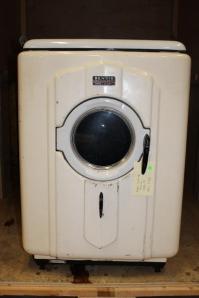
Bendix produced the first front loading automatic washing machine, in effect the one that today’s machines are modeled on. This is a slightly later version of this (1950). It had to be anchored to the floor to stop it moving off on its own!!
There are some who would dismiss them as a load of old junk, others might be old enough to remember using them, or at least conjure up memories of parents using them, in this instance it is about reminiscence. Those of a more mechanical persuasion might be fascinated with how these machines worked, and how they help explain the development of modern machinery. There are some who look at these machines as something aesthetically pleasing, objects that fit in with a particular retro style they like. Of course in reality this list could be infinite.
Whilst I understand the aforementioned perspectives, none of them accurately describe how I feel about these washing machines and why I value them as objects. The study of history and trying to make sense of and understand the past is in equal measures thrilling, satisfying, reassuring and enlightening to me. It is precisely because of history that I appreciate these washing machines. Each individual machine might be able to tell the story of its owner, but collectively they also help tell the story of a changing society.
It is easy to dismiss something as innocuous as a washing machine as unimportant in the history of mankind. But consider this; washing machines alongside other new inventions such as hoovers, fridges and electric ovens revolutionised the way we lived our lives. Not only did they ensure that previously time consuming household tasks could be completed in a fraction of the time, but their manufacture and sale helped to revolutionise our economy and fuelled an economic boom that radically improved living standards for all.
When they were first manufactured most people lived without electricity, the very poorest lived in bug infested slums without even the most basic comforts, like hot running water. Yet, in the space of 30 years and following the devastation of a World War, society had drastically changed and for the better.
The welfare state had been created offering the poorest protection from the worst effects of poverty, increasingly people had electricity. The housing stock was improved as new houses were built and slums pulled down and coupled with this was the post war economic boom bringing with it 20 years of prosperity. For the first time even the poorest were able to join in with the purchase of luxury consumer goods like washing machines. As more and more people could purchase these products prices tumbled thus making them available to people even lower down the social order and providing work in the factories where these goods were produced.
These machines help to explain a vastly changing society, not just in Britain, but in North America and Western Europe too. I understand from reading books that in the 20 years following world war two that millions and millions of people were lifted out of poverty, that living standards improved for practically all segments of society and that the affordability of new consumer products was one of the main facets of improved living standards. I understand all of this, but to actually see and be able to reach out and touch a physical manifestation of this period of history of which I am so interested is what excites me about these washing machines.
In my opinion (and I am sure some might disagree) the period between the 1930s and the 1960s saw the biggest change (for the better) in living standards that the Western world has ever witnessed. For people who lived in poverty through the 1920s and 30s and then had to endure the Second World War, the contrast between that and the relative prosperity of 1950s and 60s must have been huge.
I think this quote from former Prime Minister Harold Macmillan in 1957 sums up the mood of the period:
‘Let us be frank about it: most of our people have never had it so good. Go round the country, go to the industrial towns, go to the farms and you will see a state of prosperity such as we have never had in my lifetime – nor indeed in the history of this country’
Some studies have controversially argued that these inventions did more for women’s liberation than anything else, primarily because they freed up women’s time affording them greater opportunities to enter the workforce or gain further education. This however is an opinion that many feminists reject. What is for certain is that these new consumer luxuries changed the day to day routine of the people who used them, washing clothes had previously been an incredibly time consuming process and if nothing else these new products helped ensure that families could enjoy more leisure time, funded by their new found disposable incomes.
The consequences for the easing of the day to day pressures under which people previously lived were huge. The new generation that grew up in these halcyon days in the 1950s and 60s did not have to fight a war like their parents and did not have to struggle just to survive like their grandparents, this allowed people the freedom to think critically about the world. It was out of this period that a new wave of feminism developed, the civil rights movement gained more ground, youth movements brought sexual liberation and environmental activism and with the Cold War as the backdrop to people’s lives people increasingly questioned their governments and the choices they made. It was ideas formulated in this period that inform much of what in 2013 we consider moral and ethical.
The combination of free time and increased prosperity brought about a youth revolution, for the first time young adults came to be seen as distinctly different from their elders, they acted differently as well. Teenage rebellion was born, teenagers sought to express themselves in the way they dressed, the films they watched, the drugs they took and most importantly by the music they listened to. Rock n Roll was thought to be the devil’s music and chief culprit in the 1950’s was one Elvis Presley whose provocative and sexualised dance moves shocked a generation of parents. Later as the 1960’s arrived the counter culture boomed and acted as a vessel for the manifestation of the many different ideas the new generation had about the world.
Museum objects have value to different people for different reasons, but for me it is usually because their association with a particular period in history excites my imagination and brings the past to life.
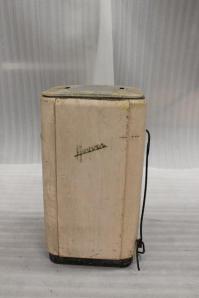
Single tub Hoover washing machine with a white finish and the make ‘Hoover’ in black on the front. The machine is inscribed with ‘ By Appointment to H.M. King George VI / Manufacturers of Electric Suction Sweepers / The Hoover Trademark Electric Washing Machine / Patents applied for in all principal countries / made by Hoover Ltd. Great Britain’. Dates from about 1940.
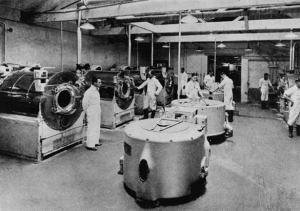
The first manual washing machine was developed as early as 1797, by the mid eighteenth century commercial steam powered machines were in use and by the turn of the 20th century even some powered by petrol, however it was not until the 1930’s when most homes started to have electricity that a domestic version of a washing machine became available. This image is of Swan laundry, Heigham, in the 1930’s.
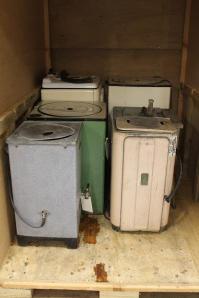
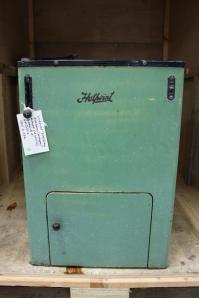

Reblogged this on Old School Garden.
LikeLike
Awesome post i had a great experience of this Automatic washing machine its very easy to operate it and very helpful for my daily life
LikeLike
Very nice collection of 6 year early washing machine…
LikeLike
keeping a old thing or machine is a very innovative idea and i am doing the same, the technologies is chaged all the thing.
LikeLike
Yes i appreciated that its time for changing because now there is a so many technologies in market to wash clothes.
LikeLike
Of course I agree about that post.now a days there are so many technologies in market and its very knowledgeable.
LikeLike
It was ideas formulated in this period that inform much of what in 2013 we consider moral and ethical.
LikeLike